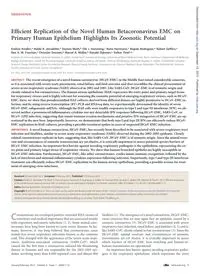
2013 Efficient Replication of the Novel Human Betacoronavirus EMC on Primary Human Epithelium Highlights Its Zoonotic Po PDF
Preview 2013 Efficient Replication of the Novel Human Betacoronavirus EMC on Primary Human Epithelium Highlights Its Zoonotic Po
Efficient Replication of the Novel Human Betacoronavirus EMC on Primary Human Epithelium Highlights Its Zoonotic Potential Eveline Kindler,a Hulda R. Jónsdóttir,a Doreen Muth,b Ole J. Hamming,c Rune Hartmann,c Regulo Rodriguez,d Robert Geffers,e Ron A. M. Fouchier,f Christian Drosten,b Marcel A. Müller,b Ronald Dijkman,a Volker Thiela,g Institute of Immunobiology, Kantonal Hospital, St. Gallen, Switzerlanda; Institute of Virology, University of Bonn Medical Center, Bonn, Germanyb; Department of Molecular Biology and Genetics, Centre for Structural Biology, University of Aarhus, Aarhus, Denmarkc; Institute of Pathology, Kantonal Hospital, St. Gallen, Switzerlandd; Genome Analytics Group, Helmholtz Center for Infection Research, Braunschweig, Germanye; Viroscience Lab, Erasmus Medical Center, Rotterdam, The Netherlandsf; Vetsuisse Faculty, University of Zürich, Zürich, Switzerlandg E.K., H.R.J., and D.M. contributed equally to this work. R.D. and V.T. contributed equally to this work. ABSTRACT The recent emergence of a novel human coronavirus (HCoV-EMC) in the Middle East raised considerable concerns, as it is associated with severe acute pneumonia, renal failure, and fatal outcome and thus resembles the clinical presentation of severe acute respiratory syndrome (SARS) observed in 2002 and 2003. Like SARS-CoV, HCoV-EMC is of zoonotic origin and closely related to bat coronaviruses. The human airway epithelium (HAE) represents the entry point and primary target tissue for respiratory viruses and is highly relevant for assessing the zoonotic potential of emerging respiratory viruses, such as HCoV- EMC. Here, we show that pseudostratified HAE cultures derived from different donors are highly permissive to HCoV-EMC in- fection, and by using reverse transcription (RT)-PCR and RNAseq data, we experimentally determined the identity of seven HCoV-EMC subgenomic mRNAs. Although the HAE cells were readily responsive to type I and type III interferon (IFN), we ob- served neither a pronounced inflammatory cytokine nor any detectable IFN responses following HCoV-EMC, SARS-CoV, or HCoV-229E infection, suggesting that innate immune evasion mechanisms and putative IFN antagonists of HCoV-EMC are op- erational in the new host. Importantly, however, we demonstrate that both type I and type III IFN can efficiently reduce HCoV- EMC replication in HAE cultures, providing a possible treatment option in cases of suspected HCoV-EMC infection. IMPORTANCE A novel human coronavirus, HCoV-EMC, has recently been described to be associated with severe respiratory tract infection and fatalities, similar to severe acute respiratory syndrome (SARS) observed during the 2002-2003 epidemic. Closely related coronaviruses replicate in bats, suggesting that, like SARS-CoV, HCoV-EMC is of zoonotic origin. Since the animal reser- voir and circumstances of zoonotic transmission are yet elusive, it is critically important to assess potential species barriers of HCoV-EMC infection. An important first barrier against invading respiratory pathogens is the epithelium, representing the en- try point and primary target tissue of respiratory viruses. We show that human bronchial epithelia are highly susceptible to HCoV-EMC infection. Furthermore, HCoV-EMC, like other coronaviruses, evades innate immune recognition, reflected by the lack of interferon and minimal inflammatory cytokine expression following infection. Importantly, type I and type III interferon treatment can efficiently reduce HCoV-EMC replication in the human airway epithelium, providing a possible avenue for treat- ment of emerging virus infections. Received 20 December 2012 Accepted 4 February 2013 Published 19 February 2013 Citation Kindler E, Jónsdóttir HR, Muth D, Hamming OJ, Hartmann R, Rodriguez R, Geffers R, Fouchier RAM, Drosten C, Müller MA, Dijkman R, Thiel V. 2013. Efficient replication of the novel human betacoronavirus EMC on primary human epithelium highlights its zoonotic potential. mBio 4(1):e00611-12. doi:10.1128/mBio.00611-12. Editor Michael Buchmeier, University of California, Irvine Copyright © 2013 Kindler et al. This is an open-access article distributed under the terms of the Creative Commons Attribution-Noncommercial-ShareAlike 3.0 Unported license, which permits unrestricted noncommercial use, distribution, and reproduction in any medium, provided the original author and source are credited. Address correspondence to Ronald Dijkman,
